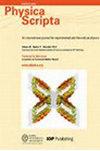Transfer of nonclassical correlations between bosonic field and atomic ensemble through electromagnetically induced transparency
IF 2.6
3区 物理与天体物理
Q2 PHYSICS, MULTIDISCIPLINARY
引用次数: 0
Abstract
Dark state polariton, as an important concept in the mechanism of electromagnetic induced transparency (EIT), can map the state of bosonic fields to atomic ensembles. To reflect the mapping ability of dark state polariton, we choose the odd and even bosonic coherent states as the probe field in EIT process, and employ spin squeezing, entanglement, and quantum correlation to characterize nonclassical correlations of atomic ensembles during the manipulation of the driving field. It is shown that the differences between the odd and even coherent states are comprehensively reflected in the three characterizations of nonclassical correlations generated through dark state polaritons. The even bosonic coherent states can perfectly transfer bosonic squeezing into atomic ensembles, resulting in spin squeezing. Although the odd bosonic coherent states cannot induce the spin squeezing, they have an advantage over the even bosonic coherent states in generating quantum entanglement and quantum correlations. Furthermore, we demonstrate that atomic ensembles can achieve significant spin squeezing with squeezing degree ∝ 1/N2/3 through the one-axis twisting (OAT) model and two-axis twisting (TAT) model under the large N limit with the low excitation conditions, and the EIT mechanism was used to transfer the generated spin squeezing to the bosonic field, providing a feasible strategy for obtaining significant bosonic squeezing.通过电磁诱导透明度传递玻色场与原子集合之间的非经典相关性
暗态极化子是电磁诱导透明(EIT)机制中的一个重要概念,它可以将玻色场的状态映射到原子团中。为了反映暗态极化子的映射能力,我们选择了奇数和偶数玻色相干态作为电磁诱导透明过程中的探测场,并利用自旋挤压、纠缠和量子相关来表征原子团在驱动场操纵过程中的非经典相关性。研究表明,奇数相干态和偶数相干态之间的差异在暗态极化子产生的非经典相关性的三种表征中得到了全面反映。偶数玻色相干态可以完美地将玻色挤压转移到原子集合中,从而产生自旋挤压。奇数玻色相干态虽然不能诱导自旋挤压,但在产生量子纠缠和量子关联方面却比偶数玻色相干态更具优势。此外,我们还证明了在大N极限的低激发条件下,原子团结可以通过一轴扭转(OAT)模型和两轴扭转(TAT)模型实现挤压度∝1/N2/3的显著自旋挤压,并利用EIT机制将产生的自旋挤压转移到玻色场,为获得显著的玻色挤压提供了可行的策略。
本文章由计算机程序翻译,如有差异,请以英文原文为准。
求助全文
约1分钟内获得全文
求助全文
来源期刊

Physica Scripta
物理-物理:综合
CiteScore
3.70
自引率
3.40%
发文量
782
审稿时长
4.5 months
期刊介绍:
Physica Scripta is an international journal for original research in any branch of experimental and theoretical physics. Articles will be considered in any of the following topics, and interdisciplinary topics involving physics are also welcomed:
-Atomic, molecular and optical physics-
Plasma physics-
Condensed matter physics-
Mathematical physics-
Astrophysics-
High energy physics-
Nuclear physics-
Nonlinear physics.
The journal aims to increase the visibility and accessibility of research to the wider physical sciences community. Articles on topics of broad interest are encouraged and submissions in more specialist fields should endeavour to include reference to the wider context of their research in the introduction.
 求助内容:
求助内容: 应助结果提醒方式:
应助结果提醒方式:


